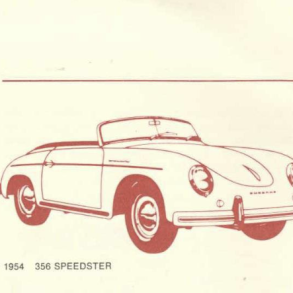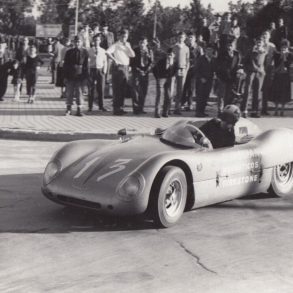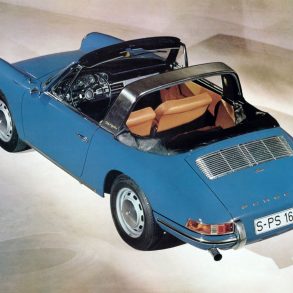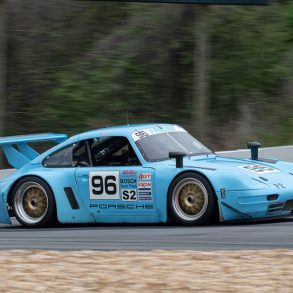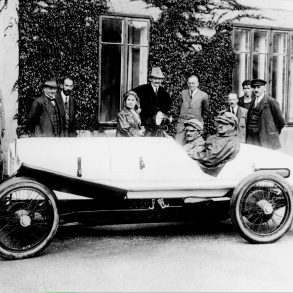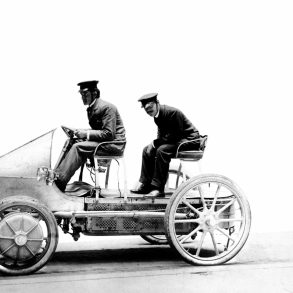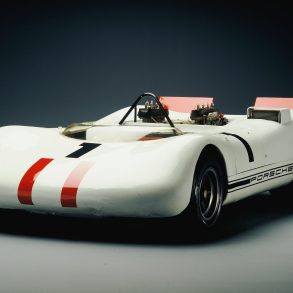The Audiobahn E6: The Porsche 911 Turbo & The 935
Welcome to The Audiobahn, the Stuttcars.com podcast focused on all things Porsche. In our first series, we’re exploring the history of venerable 911: its history, origins, achievements, and future.
The Audiobahn E6: The Porsche 911 Turbo & The 935.
Read the Podcast Transcript
B: Hey everyone, and welcome to the Audiobahn your Porsche podcast. I’m Brayden Clark. And this is Chris Carnduff we dive into the articles written on stuttcars.com and turn them into these informative and hopefully, Podcast episodes, this series we’re looking into the history of the 911, all the way from the 356 up until modern times. Last episode, we dove into the Porsche G series.
Chris gave is a really good breakdown of that and this week we’re gonna be looking at the 911 Turbo. As well as the 935, an absolute beast of a machine. Chris, are you looking forward to, we’re doing some technical, we’re diving, diving this, we’re diving into some technical stuff this week. Yeah,
C: we got technical language coming up, uh, which I’m really excited for.
Good. Um, I had a blast of a time writing this, writing this script. I, I think this one’s a good one. Um, but yeah, so for everybody out there, if you already know everything you want to know about compression ratios, um, then there will be a moment of this podcast. That you, you don’t need to listen to. Um, we’re just gonna be going over that again.
Um, but it’s really important, like we have to talk about it. It’s, it’s impossible to communicate what’s going on during this, this time period without talking about it. So I am pumped to get into technical language here.
B: Okay, so nine 11. And the 9 35 and a bit of the 9 34. We’re gonna touch on that. Bitty, bitty a little bit like yeah,
C: there will be, be people out there and going, well, you can’t talk about the 935 without talking about the 934.
Like Yeah, you’re absolutely right. But it’s just like, it’s just dipping, dipping our finger into the water, you know, just, just a little bit.
B: Okay. Are you ready? I’m ready. Are you ready? I’m ready. Let’s
go.
How do we start this section again?
C: So, Brayden I have it written down here. So Brayden, you remember the 911 R? I do remember the 911 R. Remember how it was a alation special? I do remember that. So, It like it ended, right? Because Porsche didn’t really have the budget to go and make 400 or 500 models of it.
B: Right, exactly.
C: So in, and, and we said that, don’t worry, like Porsche’s gonna get back into the racing game. It’s just gonna wait in a second. So, In 1972, that little voice at the back of the Porsche engineer’s head was whispering. Sweet. Nothings about racing. A 911 in a race series again.
B: Beautiful analogy.
C: And then he decided,
B: I just imagined a bunch of schizophrenic Porsche engineers. I love it. Yeah, go on. Thank you.
C: And they’re all sitting there having, having beers and looking at each other. Like, are you hearing that too? It’s like I’m hearing that too. Sorry. It’s the valkraes calling to them. Um, so they, uh,
B: Vaugner would be proud.
C: So they decide that, you know what, yeah, it’s, it’s time and they really wanna race in. Group five. Okay. So at the time FIA had six different groups that you could race in. 1, 2, 3, 4, 5, and six. And they wanted to race in group five specifically. So in order to be homologated in that there was a, there was a whole process.
The first thing that they had to do was they had to have 400, um, homologation special models available for customer sale for 24 months, um, in order to be homologated Okay. Into group four. Interesting. And the reason that’s important is because the homologation requirements for Group five was that the Group five model was a variant on either a group three or group four model.
Interesting. So they had to go create a group four model, houlgate it, and then they could make the variant for the group five. Okay. All of this led to the creation of a few different cars. Okay. The 9 34 was one, the 9 35 was one, and of course the nine 11 Turbo, the Home Alligation special. Do you want to give us a few quick stats on the nine 11
Turbo?
I will absolutely give you some stats on the nine 11 Turbo. I’m gonna see how well I’ve. I’ve got these stats to memory and then I’m gonna look at my notes because it’s gonna be wrong. So from a 3.0 liter engine, um, it was generating 260 brake horsepower, uh, giving us a not to 60 of 6.1 seconds. Top speed of 150.
Sounds all pretty close to me.
153 miles per hour. The only one that I don’t have memorized is torque and weight. So it generated a lovely 254 pound feet of Fork of Torque. . How many knives did it have? shut up, um, at 4,000 rpm, and it weighed a grand total of 2,635 pounds.
Wow. Yeah. How many spoons is that?
I hate you. .
B: 2000 pound feet of fork. Anyways, go on. That’s
C: a dangerous car. Yeah, it’s a dangerous car. And we went into it quite a bit last week about what made it so dangerous, and it’s not so much that it was designed as a dangerous car. It certainly wasn’t. It was designed as a car that you needed to be a good
B: driver for.
Yeah. And it was largely unexpected by the. Uh, audiences who were used to a front engine
C: muscle car. You got it. And they were also used to seeing numbers that were double what they saw. Right. So they were kind of, they were lured in by the expectation. Somewhat tame horsepower. Exactly. Um, so much so that the nine.
11 Turbo, um, in the US it was called the nine 30, uh, gained the nickname the widow maker understand, which is kind of terrifying in its own right. But enough people owned it, survived that. We can have enthusiasts who are like, this is one of the coolest cars ever made. And they’re absolutely right. And what I think is one of the coolest parts about it is the rear spoiler.
Okay, the whale tail spoiler. Mm. And the reason for this is because while the rest of the automotive manufacturing world, all the engineers and their dogs were going to liquid cooling. Yep. Porsche was still using air cooling on their engines. So for turbos, you want nice, thick, cold air. Yeah. So they put intercos on for the turbos.
Um, Whenever you’re running that hot, because turbo’s put out a ton of heat, right? Yep. Like with the redirection of the exhaust through the turbo charger, you’re holding more heat at the head. Yep. And that’s, that’s not doing great things. Right. So in order to cool down the engine even more, you have to redirect more air to it.
Yeah. So, whereas a rear wing usually just creates or provides that down force to keep the rear end of the car down. I mean, certainly a 260 horsepower, super light, extraordinarily nimble car needs that down force. Yeah. The other thing that that wing is providing is airflow onto the cooling fins.
Interesting. So, yeah, it, it doesn’t just act as like, oh, well you can take a turn quicker, or, you know, you’d be quicker off the line. Yeah, yeah, sure. But you’re also making it a viable cooling option for your cart. Interesting. Is an engineering bit of like, just, that’s just tasty. It’s great. I think it’s, the engineers at Porsche really knew what they were doing.
And we also have to remember why this was created, right? Like this was a homologation special. Yeah. So the car that the nine 11 Turbo was Ululating was the 9 34 or the group 4 9 30.
B: Oh, okay. And then they modified that to become the 9 35.
C: You got it. Whew. Speaking of which, do you want to run through some quick stats there for the 9 35 for us?
B: Absolutely. Okay. So this was an absolute beast. I don’t have these memorized, but let’s take a look. So from a 3.3 liter, so uh, 0.3 of a liter larger, you’re getting a disgusting 845 brake horsepower at 8,200 rpm. And that’s giving you 572 pound feet of torque , uh, for anot to 60 of, again, this is the 1970s, so this is just terrifying anot to 60 of 2.6 seconds and the top speed of 227 miles per hour.
This thing is, Terrifying.
C: It’s stupid. Cool. Oh yeah, yeah. , it’s, it is stupid. Cool. I want one, I think. Yeah. Yeah. Um, but like, not to drive, because I know I couldn’t handle a nine 11 turbo. No, I know like that in every life that I ever lived in the multiverse, I would not be a race car driver that would be able to handle all 9 35.
It is beyond the capabilities. Of what I even can imagine myself.
B: Yeah, that’s and all that weight in the rear too. Like you’ve gotta be good to handle
C: that kind of power. It’s incredible. Yeah. Like it’s an insane car. Those are insane numbers for today. Yeah. Like it’s putting out almost 850 horsepower.
Yeah. Like, my God. Like we’re just getting to the point now where we’re having that. Production muscle cars. Right. Like the Hellcat engine that’s in those Hellcat Dodges, like that’s putting out 800 horsepower. Yep. Like today. Yep. This is the 1970s man. Right. Um, but they get there through sheer force of engineering.
Yeah. And they do it in a couple of. First of all, they have the Bosch fuel injection system, that mechanical fuel injection system that we talked about. Yep. And second of all, they do it through a turbo charger Now. This isn’t like the home alligation special. This isn’t like the nine 30. The nine 30 had, you know, 260 horsepower through one turbo.
The 9 35 doesn’t just have one turbo. It has two massive turbos. This is a huge twin turbo set up that they have. Yeah. The reason why it has power at such high RPM is because, and such low torque to power, right? Like it has 845 horsepower and only is what, 505. 572 pound feet of torque. The reason why is because the spool, like the lag on those turbos was incredible because of how big they were.
So they had to have this whole setup for it. Now, This is where we get technical. We have to talk about compression ratios. There’s bring it on, no way around it. So buckle in. We’re gonna talk about some technicalities.
B: If I had nerdy glasses, I would push them up right now, . So you do.
C: Here, let me, yeah. You see this?
There’s actually, there’s a part of my glasses. You see that? It’s, it’s worn out
B: from being a, compression B.
C: You are great. Okay, now I’m gonna
B: need those bags. I can, is bad that I can see better with it. good.
C: Cool. Yeah. Maybe we should get, get your eyes checked there. Yeah. Um, so compression, compression ratios tell you in comparison to the combustion chamber, how much of an area is swept by the pistons?
Okay. That’s a little bit technical. So, A 9.0 to one compression ratio is telling you that the piston sweep nine times what the combustion chamber is. Okay. So the combustion chamber is that little slot at the very top, like very bottom of the head, very top of the, yep. Of the stroke. And that is like, you’re, you’re one that’s your combustion chamber and you multiply that for how much the, the peston sweeps.
Yep. What it’s telling you isn’t just that it’s sweeping that it’s also describing how much air and fuel it’s squeezing into the combu, the combustion chamber, right? Yeah. So it’s not just sweeping nine times, it’s squeezing nine times the amount of air and fuel that the combustion chamber would have during regular atmosphere pressure.
Into that area. Yeah.
B: Because the higher the ratio, the higher the amount of
C: pressure, the bigger the bang. Yep, yep. Um, the bigger the bang, the more power you get on your power stroke. Everybody’s happy. Right? Yeah. Um, so there’s a couple ways of modifying how much. Pressure you have, like there’s a couple ways of modifying that.
The first way is to modify the piston stroke. Yep. So that you have a higher, so you have a higher compression ratio. So this is where. The, the piston is stroking or literally displacing that amount of air and fuel. This is where they’re saying, you know, there’s no replacement for displacement comes from.
Right. Um, now the other way to do that isn’t by affecting the, the stroke or the sweep. It’s by. Forcing more air into the system. Yep. The way that fuel systems work is that they meter to the amount of air that’s flow through, so you’re forcing more air in. You’re also forcing more fuel in. Okay. This is what’s called forced induction, and this is what a supercharge or turbocharge does.
Yep. So what you’re doing is you’re increasing the atmospheric pressure from outside. So instead of just the regular, you know, natural vacuum created by the piston, you are shoving as much in as you possibly can. And this is, you’re shoving in more pounds, like more pressure, more pounds per square inch into it.
And this is where the expression, how much boot, how many pounds of boost are you running? Yep. Right. So there you go. There’s the explanation for the two 20 year olds. You’re ever gonna see it at swat Meet . You waited all last episode and we got there today. now forcing more air. Fuel has an advantage of not simply relying on the atmospheric pressure.
Um, In the seventies, people who weren’t engineers weren’t totally sure. Um, and you know what one was necessarily better? Yep. Uh, if more displacement or, you know, forced induction was the way. But people who were engineers of race teams knew that forced induction had the potential to far. You know, just by orders magnitude far outweigh the amount displacement.
You got it. Right? Because by just increasing the displacement, you’re still relying on atmosphere pressure. Yeah. There’s no way you can make a piston big enough that a turbocharge can’t just shove more air and fuel into that. Yep. But there is a trade off, and that trade off is in your compression ratio because in a normal non force induction engine or a normal NA engine, That piston is moving up and it’s only fighting the atmosphere.
Yep. But as soon as you start shoving more air in there, it’s fighting more than just the atmosphere. And when the bang happens and you have too high of a compression ratio, the bang doesn’t just give you more of a power stroke. It also throws a rod.
Yes. So if you want an engine that has a turbo charger on it, you have to play around a little bit. So what they did for the nine 11 turbo is they lower the compression ratio, right? Whereas the nine 11 s. In 1974, I had a compressor ratio of about 9.0 to one. Okay. Um, the, the nine 11 turbo was running a compression ratio of 6.5 to one.
Okay. So shorter, obviously. Yeah. But still producing more power. Yep. Right, because it doesn’t actually, like, you’re still gaining more compression on that turbo, even though the compression ratio is smaller. Yep. Makes sense. And there’s our technical language, everybody. I’m back all, you know, we’re, we’re all good.
Made it through. Wait, there’s a, I think, a fairly comprehensive overview of what a compression ratio is.
B: Okay. Now how does that tie into the 9
C: 35? So let me tell you the cool stuff that they did with the 9 35, cuz oh boy, they didn’t just take one turbo and throw it onto this engine. They took two turbos and threw onto this engine.
Yeah. And then they also looked at it and went, you know what? You know what this isn’t gonna do, what this car is not gonna do. It’s not gonna be, you know, cruising up and down Ventura b. It’s not gonna be daily driven. It’s gonna be driven by a race car driver over the course of a racing season. And it, you know, the engine can blow up at the end of the season.
We don’t care. So why don’t we increase the compression ratio on the engine they bring up from 6.5 to one to seven to one, which doesn’t sound like a lot, but it’s a whole bunch. Yep. And they have two turbos shoving as much air and fuel into this thing as possible like it is. The amount of boost to writing is wild.
B: These guys have way too much fun. Yeah, right. I’m jealous of their jobs. I,
C: yeah, it’s, it’s one of those kind of moments that you’re looking at in, in any kind of history, you know, man, what would’ve been like
B: the, the chaotic person who suggested that, they’re like, guys, I know we have two turbos on here, but let’s just make the compression race here bigger.
Let’s, let’s just do it. It’s, it’ll eventually blow.
C: Yeah, but like, we’ll just rebuild it. Yeah, yeah. We’re allowed like four engines, you know, for the season, right? Yeah. Perfect.
B: Like, it’s easy. We’ll just go for it. That’s brilliant. I love that. It’s
C: awesome. Yeah, and it’s combined with all the cooling that they were doing and with the, with the induction they had and with the compression they had and with the, the fuel delivery system that they had, they managed to take a three liter engine.
Um, well, a 3.3 liter engine. It’s actually 3,211 cc, but because of FI regulations it’s 3.3. They managed to take a 3.3 liter engine and make 845 horsepower out of it, and it’s air cooled Braden, it’s
B: still air cooled it. Someone had way too much fun when they saw those numbers at the end. They must have had like a little evil maniacal laugh, just like 800 plus.
800
C: plus horsepower. It goes mock chicken and mock chicken. It goes zero, 60 and don’t blank like it is. Yeah, it
B: is. The 2.6 seconds is mind numbingly fast
C: is wildly quick. Yeah. So the 9 35 was a legendary race car and it cleaned up Yeah, in the 370 races that it was involved in, that nine through five s were involved in in the seventies there.
It won. It didn’t just place in the top three. It straight up won 123 of them.
It’s a staggering record, right? Like it’s up against everything else. Every other auto manufacturer of its time like, And it is like it absolutely cleans up and it dominates for years. It, it’ll go in and it wins Daytona and Seabring and Lamar 24 hours and the thousand nearing something that’s common with all these as well.
I should mention, these are all Enduro races, right? Like 24 hours of Lamar is a grueling race on any engine. And again, this is an air cool twin turbo engine from the seventies with a way too high compression ratio. And it’s winning the Enduro races. Yeah. So it’s not just like, oh, this is well engineered.
It’s like this engine was put to the absolute. And the engineering made it so that it was able to handle it. Yeah. So it cleaned up and it just continued to clean up. The thing that stopped its dominance was that FIA changed its regulations. Interesting. In 1982, FIA went from a six group system to a three group system.
Yep. And that is pretty well when the 9 35 was like, okay, well that’s it. Yeah. But that’s like, it’s still a long rate. It’s almost a decade. Yeah. Yeah. Of technological innovation. Which again is during the seventies when a lot of that was happening. Yeah. Um, so as for the Home Ululation special, I’m gonna take this straight out of Nick DE’s work.
This paragraph is awesome. As for the Ululation special, the nine 11 Turbo, it was the top of the range nine 11 model for it’s entire production duration. And at the time of its intro, introduction was the fastest production car available in Germany. More importantly, it set the tone for the nine 11 turbo models moving forward, luxurious effortlessly fast, and the top of the nine 11 range.
That trend still continues to this day.
B: Mm. So that just kinda sets up and opens up the legend of the nine 11
C: Turbo. We’re there? Yeah, we’re there. We did all that groundwork going through and we looked at the, the. The, or sorry, the 3 56. Yep. We, you know, went through the 9 1 1 and the nine 12, and we talked about all those different variations and even like the, even the economic struggles they had with the, you know, getting the nine 11 R up and going.
Um, but we’re, we’re there like it’s, it’s happened the nine 11 at this point now of what we’re talking in the seventies. It is that super car. It is that it’s the car that the kids will have as posters up on their walls and be dreaming about. And, you know, it’s, it’s the widow maker. It’s, it’s that twin turbo legend.
You know, it, it’s the one that, you know, it, it one Lamar this many times. It’s, we’re there, the nine 11 is now an absolute legend and not just among enthusiasts. Yep. It’s, it’s a car.
B: Oh yeah. It’s made a name for itself. Yeah.
C: That’s,
B: So that is the kinda the birthplace of the legend. That is the nine 11 Turbo. We’ve, we’ve laid all this groundwork we’ve got there and we actually had a great tasty conversation about the 9 35 that I want one. Badly. It’s an issue, but, so that’s a good recap. The 9 35, um, was a variant of the 9 34, which was a, a variant of the nine 11 Turbo, sort of
C: the nine 11 turbo was the homologation regulation Yes.
You know, required for the 9 34, which was required to make the car require exactly.
B: And again, it lays the groundwork of what we know today to be the nine 11 turbo. So that’s great. That’s a really good recap. Up to there. Next week we’re gonna be touching on the eighties, what portion was up to in that decade.
Chris, those are really good recap. Thank you. Especially like the
C: compression stuff. Uh, yeah man, this was a lot of fun. This is a lot of fun to research. Um, they just get more and more fun. I think when we were going through the 3 56, it was, it was a lot of fun, but every episode it’s like, oh man, there’s something, there’s something wicked here.
Yeah. It’s Porsche is a, is never hurting for more cool stuff. Yeah.
B: And again, If you guys wanna go read the articles that we’re basing these off of, go to stu cars.com. They’ve got some of the best work on the history of Porsche on the internet. They’ve also got a really good membership program where it’s $5 a month.
You can get access to even more content and obviously you get a, uh, an ad-free experience on the website. Sir, I’m Braden Clark. This is Chris Kiff. We’ll be talking about more PORs. Next week. See you guys soon.
C: Bye.


